Geopolymer Recycled Aggregate Concrete: From Experiments to Empirical Models
Abstract
:1. Introduction
2. Experiments
2.1. Materials Used
2.1.1. Fly Ash
2.1.2. Aggregates
2.1.3. Characterization of Recycled Coarse Aggregate (RCA)
2.1.4. Aggregate Crushing Value (ACV)
2.1.5. Alkali-Activated Binder
2.1.6. Superplasticizer
2.2. Mix Proportions for GRAC
2.3. GRAC Specimen Casting
2.4. Curing
2.5. Geopolymer Mortar and Paste
- Geopolymer paste which does not contain sand: only FA and AAS were used, by using the AAS/FA ratio of 0.4, which was the same for the case of GRAC.
- Geopolymer mortar which contains natural sand but does not contain any coarse aggregate: the proportion of FA, AAS, and sand was the same as the case of GRAC.
- The third type (called “mortar-standard”) is a geopolymer mortar which contains the sand but the proportion between binder (FA + AAS) and sand respected the proportion proposed for cement mortar following standard.
3. Results
3.1. Workability of GRAC
3.2. Compressive Strength of GRAC
3.3. Microscopic Analyses
3.4. Compressive Strength of Geopolymer Mortar/Paste
4. Model of Strength Prediction for GRAC
4.1. Classical Models for Portland Cement Concretes
- Kg is the Feret’s aggregate constant, 4.5 < Kg < 5.5 for natural aggregate.
- fcm(t) is the compressive strength of cement at time t.
- and are the specific densities of cement and water, respectively.
- W and C is the mass of water and cement in 1 m3 of concrete.
- Va is the volume of air for 1 m3 of concrete.
- fc(t) is the compressive strength of concrete at age t.
- fcm(t) is the compressive strength of cement at age t (MPa).
- p and q are the empirical coefficients which depend to the aggregate quality.
4.2. Compressive Strength of Geopolymer Paste
4.3. Assessing the Relevancy of Feret’s Model
- The specific density of water is 1 t/m3. For the specific density of geopolymer binder , as this value was not directly measured in the present study, a value of 2.6 t/m3 was adopted. Indeed, this value was estimated by taking into account the specific densities of FA, Na2SiO3, Na2O, and the compressive strength of the geopolymer paste obtained (from 50–70 MPa); this value is comparable to the results presented in a previous study [43].
- The mass of water W was determined from the waters existing in NaOH and Na2SiO3 solution, corresponding to 107.5 kg of water in 1 m3 of concrete;
- The mass of geopolymer binder B: this parameter replaces the cement amount C in the classical Feret’s model for ordinary cement concrete. Therefore, the mass of binder B should be the sum of mass of the solid parts (called G) in geopolymer binder in 1 m3 of concrete; this amount G corresponds to 50.8 kg Na2SiO3, 13.72 kg NaOH, and 428 kg FA, for a total of 492.5 kg. However, for geopolymer concrete, there may be differences with the ordinary cement concrete, so a coefficient kb was introduced to take into account the potential differences, so B is replaced by kbG. Indeed, as shown in the previous sections, there were still numerous FA particles which did not participate in the geopolymerization reactions, so the value of kb can vary from 0 to 1, which will be investigated in the present study.
- The Feret’s aggregate constant Kg: the classical Feret’s model for natural aggregates indicated that Kg could vary from 4.5 to 5.5 (high value of Kg corresponds to good quality of aggregate). Some recent studies proposed some empirical relationships to calculate Kg from MDE (micro-Deval abrasion test) [44], which can be deduced from the aggregate crushing value (Section 2.1.3); however, the relevancy of these empirical formulas was also shown as limited [42]. For the present study, if that empirical relationship was applied, the value of Kg obtained would be 7.7 and 6.4 for natural and recycled aggregates in the present study, respectively. These values are not logical when compared to the usual values mentioned above. For recycled aggregates with a lower quality than natural parent aggregates, the value of Kg should be less than 4.5. The value of Kg in the case of GRAC will be investigated in this study.
- For the ordinary cement concrete, fcm(t) is the compressive strength of cement at time t, so for GRAC the compressive strength of geopolymer paste (without sand) is used (Section 4.2).
4.4. Relevancy of Modified De Larrard’s Model
5. Conclusions and Prospects
Author Contributions
Funding
Institutional Review Board Statement
Informed Consent Statement
Data Availability Statement
Conflicts of Interest
References
- Worrell, E.; Price, L.; Martin, N.; Hendriks, C.; Meida, L.O. Carbon dioxide emissions from the global cement industry. Annu. Rev. Energy Environ. 2001, 26, 303–329. [Google Scholar] [CrossRef]
- Mehta, P.K. Reducing the environmental impact of concrete. Concr. Int. 2001, 23, 61–66. [Google Scholar]
- Davidovits, J. Global warming impact on the cement and aggregates industries. World Resour. Rev. 1994, 6, 263–278. [Google Scholar]
- Davidovits, J. Soft mineralogy and geopolymers. In Proceedings of the Geopolymer 88th International Conference, Compiegne, France, 1–3 June 1988. [Google Scholar]
- Bouaissi, A.; Li, L.Y.; Abdullah, M.M.A.B.; Bui, Q.B. Mechanical properties and microstructure analysis of FA-GGBS-HMNS based geopolymer concrete. Constr. Build. Mater. 2019, 210, 198–209. [Google Scholar] [CrossRef]
- Amjadi, R.; Monazami, M.; Mohseni, E.; Azar Balgouri, H.; Ranjbar, M.M. Effectiveness of different recycled materials in self-compacting mortar. Eur. J. Environ. Civ. Eng. 2017, 21, 1485–1501. [Google Scholar] [CrossRef]
- Le, H.B.; Bui, Q.B. Recycled aggregate concretes–a state-of-the-art from the microstructure to the structural performance. Constr. Build. Mater. 2020, 257, 119522. [Google Scholar] [CrossRef]
- Oikonomou, N. Recycled concrete aggregates. Cem. Concr. Compos. 2005, 27, 315–318. [Google Scholar] [CrossRef]
- Mohseni, E.; Saadati, R.; Kordbacheh, N.; Parpinchi, Z.S.; Tang, W. Engineering and microstructural assessment of fibre-reinforced self-compacting concrete containing recycled coarse aggregate. J. Clean. Prod. 2017, 168, 605–613. [Google Scholar] [CrossRef]
- Koushkbaghi, M.; Kazemi, M.J.; Mosavi, H.; Mohseni, E. Acid resistance and durability properties of steel fiber-reinforced concrete incorporating rice husk ash and recycled aggregate. Constr. Build. Mater. 2019, 202, 266–275. [Google Scholar] [CrossRef]
- Berndt, M.L. Properties of sustainable concrete containing fly ash, slag and recycled concrete aggregate. Constr. Build. Mater. 2009, 23, 2606–2613. [Google Scholar] [CrossRef]
- Ren, X.; Zhang, L. Experimental Study of Geopolymer Concrete Produced from Waste Concrete. J. Mater. Civ. Eng. 2019, 31, 04019114. [Google Scholar] [CrossRef]
- Shi, X.; Collins, F.; Zhao, X.; Wang, Q. Mechanical properties and microstructure analysis of fly ash geopolymeric recycled concrete. J. Hazard. Mater. 2012, 238, 20–29. [Google Scholar] [CrossRef]
- ASTM 618-05. Standard Specification for Coal Fly Ash and Raw or Calcined Natural Pozzolan for Use in Concrete. In AIP Conference Proceedings; American Institute of Physics: College Park, MD, USA, 2012; pp. 860–863.
- Luisa, P.; Francesconi, L.; Rombi, J.; Mistretta, F.; Sassu, M.; Stochino, F. Effect of Parent Concrete on the Performance of Recycled Aggregate Concrete. Sustainability 2020, 12, 9399. [Google Scholar] [CrossRef]
- Vietnamese Standard Publication. Aggregates for Concrete and Mortar–Test Methods-Part 5: Method for Determination of Apparent Specific Gravity, Bulk Specific Gravity and Water Absorption of Original Stone and Coarse Aggregate Particles; TCVN 7572-5:2006; Ministry of Science and Technology: Ha Noi, Vietnam, 2006.
- Juan, M.S.; Gutiérrez, P.A. Study on the influence of attached mortar content on the properties of recycled concrete aggregate. Constr. Build. Mater. 2009, 23, 872–877. [Google Scholar] [CrossRef]
- Artoni, R.; Cazacliu, B.; Hamard, E.; Cothenet, A.; Parhanos, R.S. Resistance to fragmentation of recycled concrete aggregates. Mater. Struct. 2017, 50, 11. [Google Scholar] [CrossRef] [Green Version]
- Quattrone, M.; Cazacliu, B.; Angulo, S.; Hamard, E.; Cothenet, A. Measuring the water absorption of recycled aggregates, what is the best practice for concrete production? Constr. Build. Mater. 2016, 123, 690–703. [Google Scholar] [CrossRef]
- Vietnamese Standard Publication. Aggregates for Concrete and Mortar–Specifications; TCVN 7570:2006; Ministry of Science and Technology: Ha Noi, Vietnam, 2006.
- Butler, L.; West, J.; Tighe, S. The effect of recycled concrete aggregate properties on the bond strength between RCA concrete and steel reinforcement. Cem. Concr. Res. 2011, 41, 1037–1049. [Google Scholar] [CrossRef]
- Sagoe-Crentsil, K.; Brown, T.; Taylor, A. Performance of concrete made with commercially produced coarse recycled concrete aggregate. Cem. Concr. Res. 2001, 31, 707–712. [Google Scholar] [CrossRef]
- Chen, L.; Wang, Z.; Wang, Y.; Feng, J. Preparation and Properties of Alkali Activated Metakaolin-Based Geopolymer. Materials 2016, 9, 767. [Google Scholar] [CrossRef] [Green Version]
- Ma, H.; Zhu, H.; Yi, C.; Fan, J.; Chen, H.; Xu, X.; Wang, T. Preparation and Reaction Mechanism Characterization of Alkali-activated Coal Gangue–Slag Materials. Materials 2019, 12, 2250. [Google Scholar] [CrossRef] [PubMed] [Green Version]
- Hardjito, D.; Rangan, B.V. Development and Properties of Low Calcium Fly Ash Based Geopolymer Concrete; Research Report GC1; Faculty of Engineering, Curtin University of Technology: Perth, Australia, 2005. [Google Scholar]
- Duran, A.; González-Sánchez, J.F.; González-Sánchez, J.F.; Fernández, J.M.; Sirera, R.; Navarro-Blasco, Í.; Alvarez, J.I. Influence of Two Polymer-Based Superplasticizers (Poly-naphthalene Sulfonate, PNS, and Lignosulfonate, LS) on Compressive and Flexural Strength, Freeze-Thaw, and Sulphate Attack Resistance of Lime-Metakaolin Grouts. Polymers 2018, 10, 824. [Google Scholar] [CrossRef] [PubMed] [Green Version]
- Rangan, B.V. Fly Ash-Based Geopolymer Concrete; Research Report GC4; Engineering Faculty, Curtin University of Technology: Perth, Australia, 2008. [Google Scholar]
- Palomo, A.; Grutzeck, M.W.; Blanco, M.T. Alkali-activated fly ashes: A cement for the future. Cement and concrete research. Cem. Concr. Res. 1999, 29, 1323–1329. [Google Scholar] [CrossRef]
- Vietnamese Standard Publication. Fresh Heavyweight Concrete-Method for Slump Test; TCVN 3106-1993; Ministry of Science and Technology: Ha Noi, Vietnam, 1993.
- Hardjito, D. Studies on Fly Ash-Based Geopolymer Concrete. Ph.D. Thesis, Curtin University of Technology, Perth, Australia, November 2005. [Google Scholar]
- Chang, E.H. Shear and Bond Behaviour of Reinforced Fly Ash-Based Geopolymer Concrete Beams. Ph.D. Thesis, Curtin University of Technology, Perth, Australia, January 2009. [Google Scholar]
- Vietnamese Standard Publication. Heavyweight Concrete-Method for Determination of Compressive Strength; TCVN 3118:1993; Ministry of Science and Technology: Ha Noi, Vietnam, 1993.
- Burg, R.G. The Influence of Casting and Curing Temperature on the Properties of Fresh and Hardened Concrete; Portland Cement Association: Skokie, IL, USA, 1996. [Google Scholar]
- European Standard. Eurocode 2: Design of Concrete Structures–Part 1-1: General Rules and Rules for Buildings; EN 1992-1-1; European Committee for Standardization: Brussels, Belgium, 2004. [Google Scholar]
- Nematollahi, B.; Sanjayan, J.G. Effect of different superplasticizers and activator combinations on workability and strength of fly ash based geopolymer. Mater. Des. 2014, 57, 667–672. [Google Scholar] [CrossRef]
- Palacios, M.; Puertas, F. Effect of superplasticizer and shrinkage-reducing admixtures on alkali-activated slag pastes and mortars. Cem. Concr. Res. 2005, 35, 1358–1367. [Google Scholar] [CrossRef]
- Nath, S.; Maitra, S.; Mukherjee, S.; Kumar, S. Microstructural and morphological evolution of fly ash based geopolymers. Constr. Build. Mater. 2016, 111, 758–765. [Google Scholar] [CrossRef]
- Larrard, D.F.; Colina, H. Concrete Recycling, Research and Practice; Taylor & Francis Group: Oxfordshire, UK, 2019. [Google Scholar]
- Larrard, D.F. Concrete Mixture-Proportioning: A scientific approach, Modern Concrete Technology; Series No. 9; Bentur, A., Mindness, S., Eds.; Routledge: New York, NY, USA, 1999; ISBN 0-419-23500-0. [Google Scholar]
- Andrade, G.P.D.; Polisseni, G.D.C.; Pepe, M.; Filho, R.D.T. Design of structural concrete mixtures containing fine recycled concrete aggregate using packing model. Constr. Build. Mater. 2020, 252, 119091. [Google Scholar] [CrossRef]
- Gagné, R. Air entraining agents. In Science and Technology of Concrete Admixtures; Woodhead Publishing: Cambridge, UK, 2016; pp. 379–391. [Google Scholar]
- Ferdous, M.W.; Kayali, O.; Khennane, A. A detailed procedure of mix design for fly ash based geopolymer concrete. In Proceedings of the Fourth Asia-Pacific Conference on FRP in Structures (APFIS 2013), Melbourne, Australia, 11–13 December 2013. [Google Scholar]
- Palankar, N.; Shankar, A.R.; Mithun, B. Studies on eco-friendly concrete incorporating industrial waste as aggregates. Int. J. Sustain. Built Environ. 2015, 4, 378–390. [Google Scholar] [CrossRef] [Green Version]
- Rémond, S.; Mechling, J.M.; Garcia-Diaz, E.; Lavaud, R.; Trauchessec, R.; Cazacliu, B. Caractérisation des granulats de béton recyclé. In Le béton Recyclé; Larrard, F., Colina, H., Eds.; Ifsttar: Marne-la-Vallée, France, 2018. (In French) [Google Scholar]
- Davidovits, J. Geopolymers: Inorganic polymeric new materials. J. Therm. Anal. 1991, 37, 1633–1656. [Google Scholar] [CrossRef]
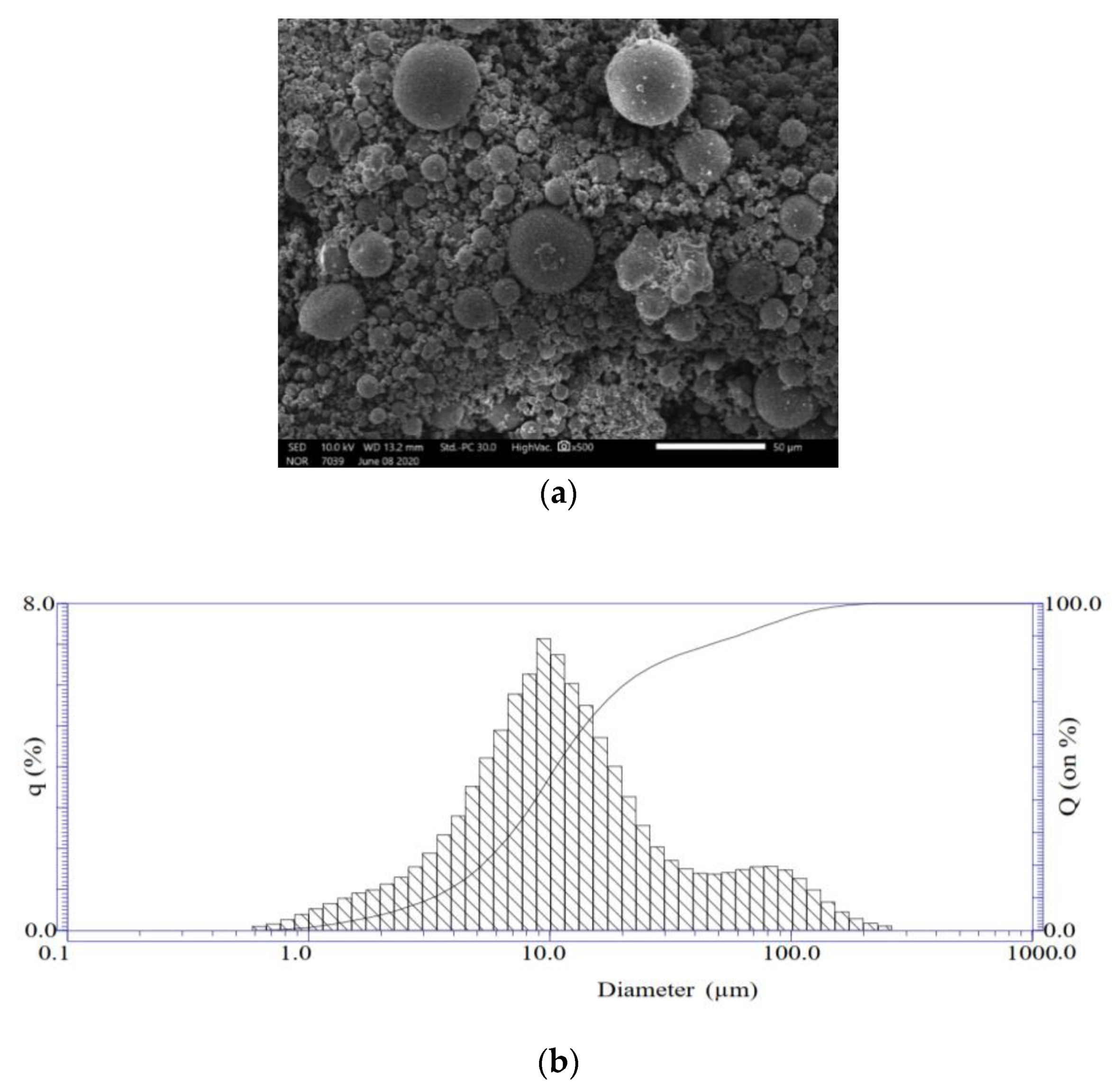
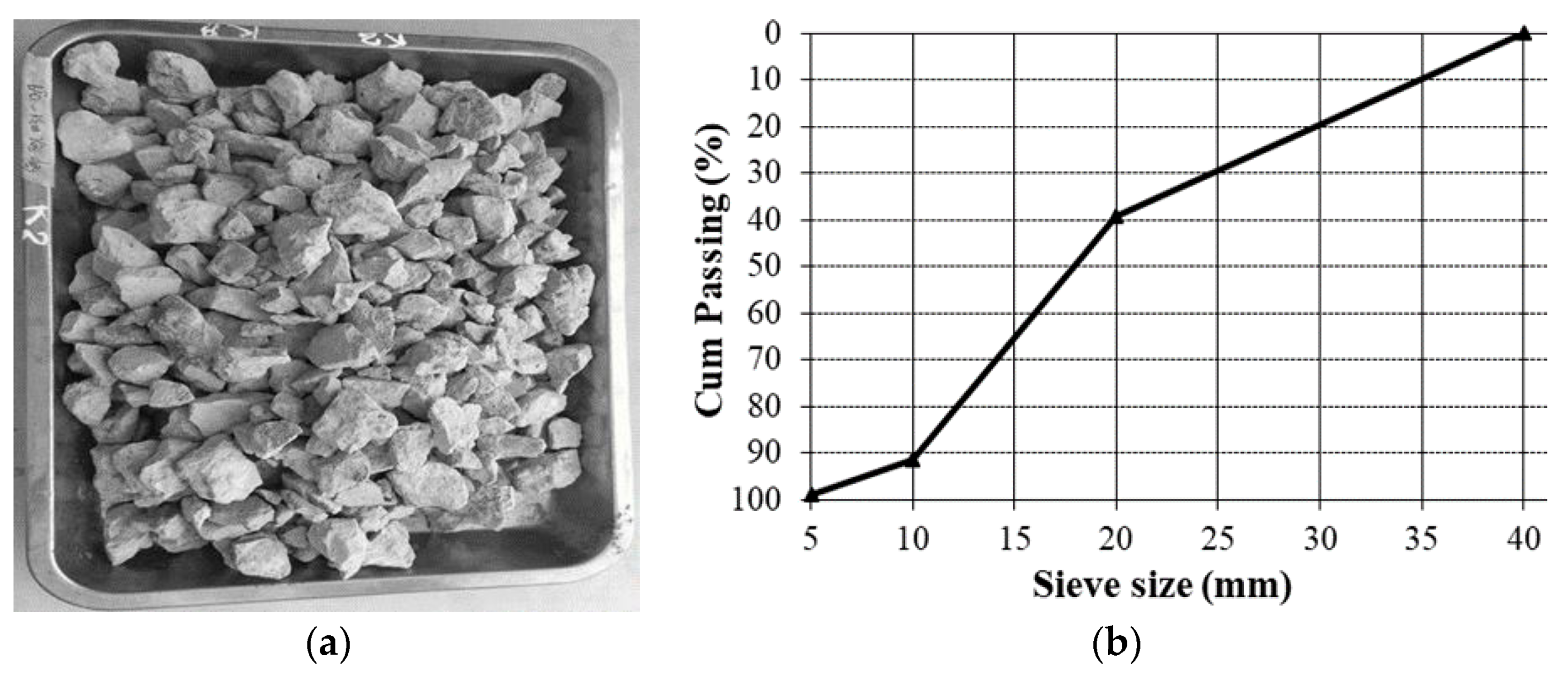




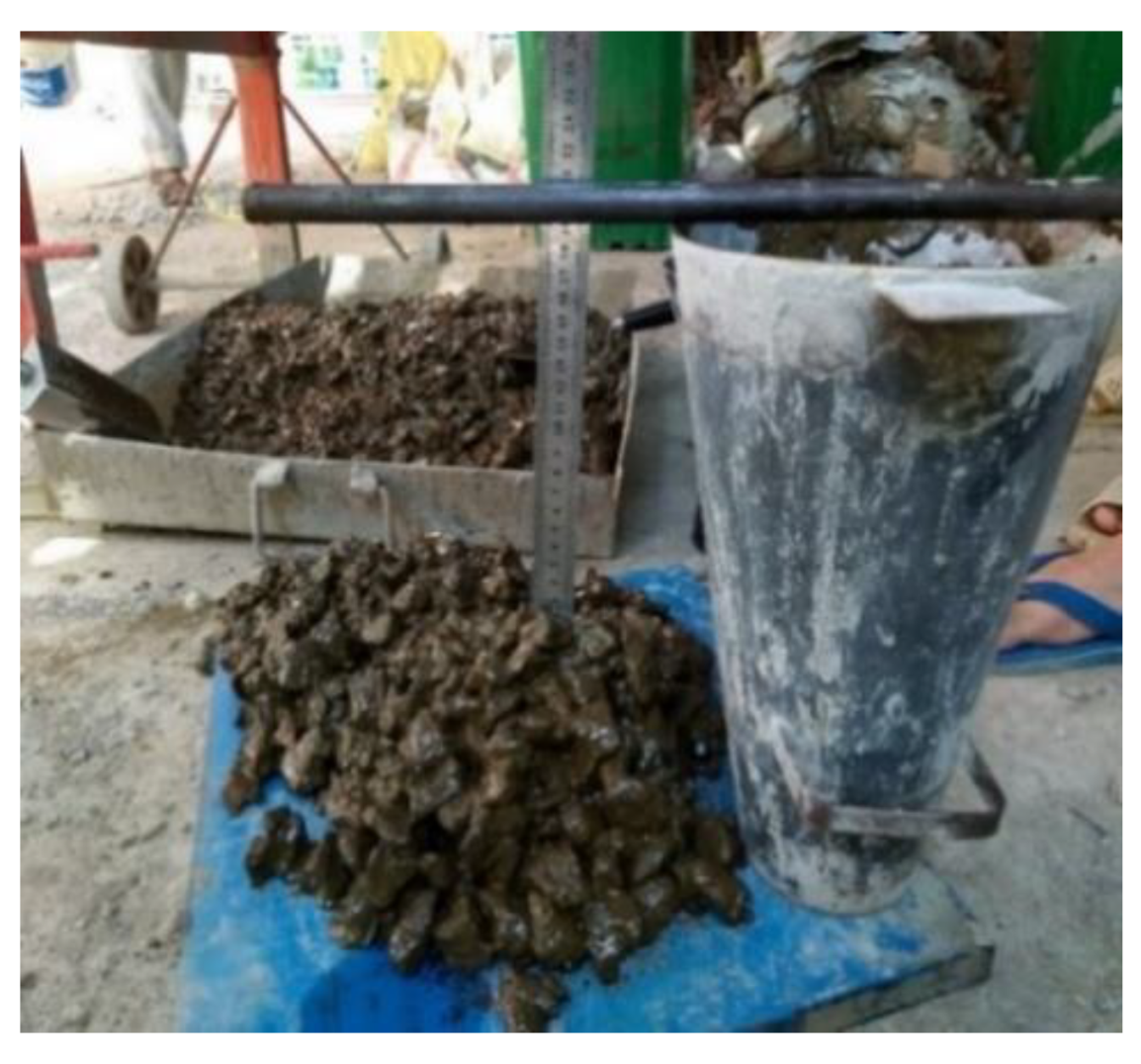
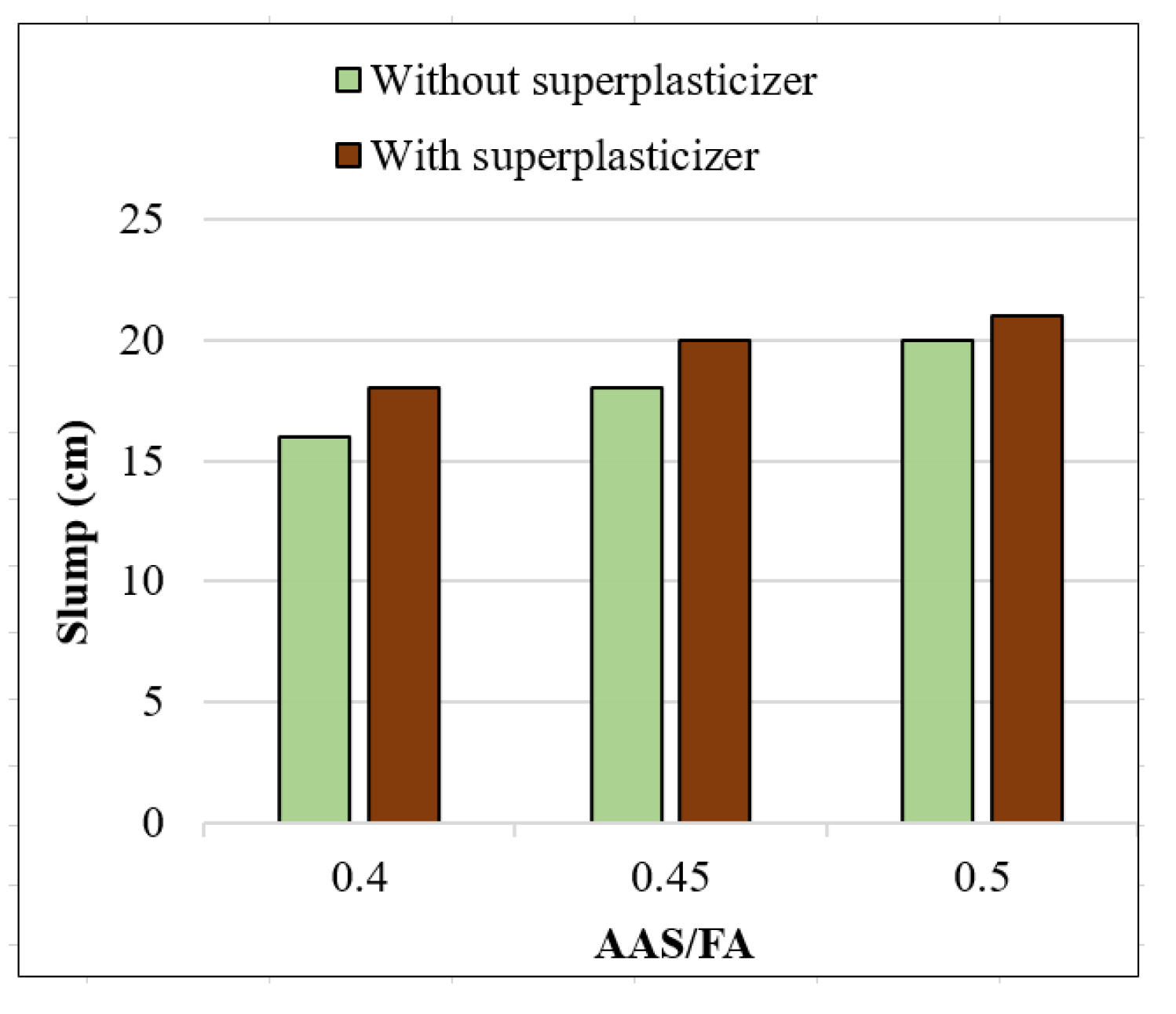

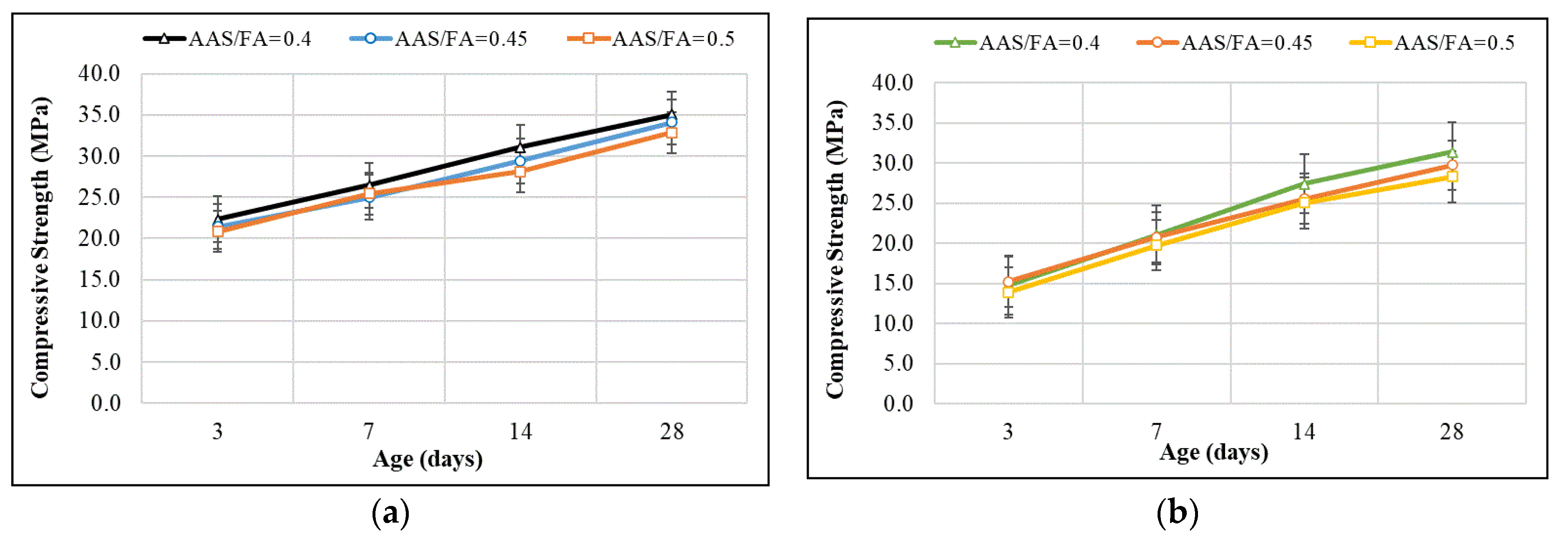
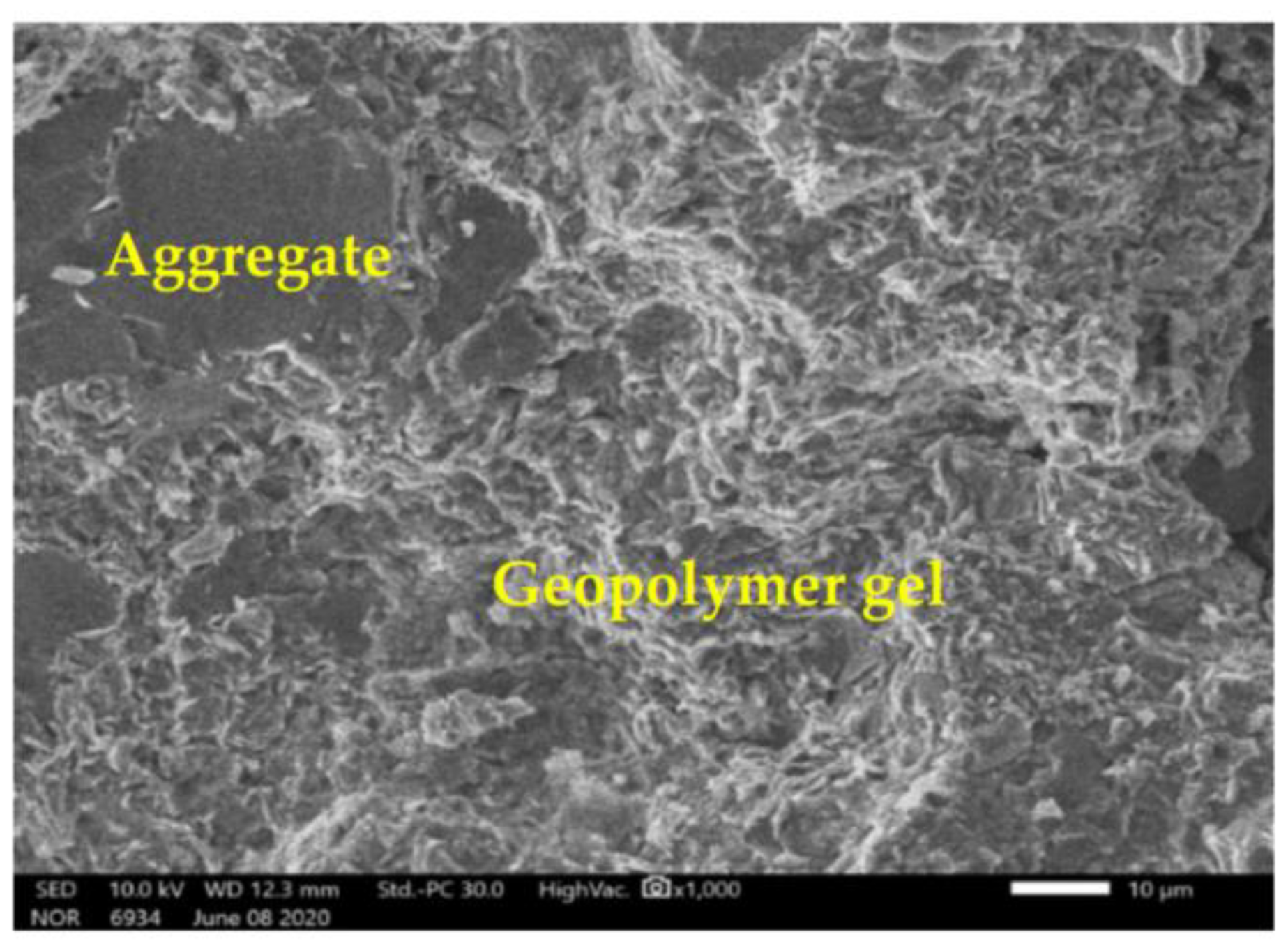
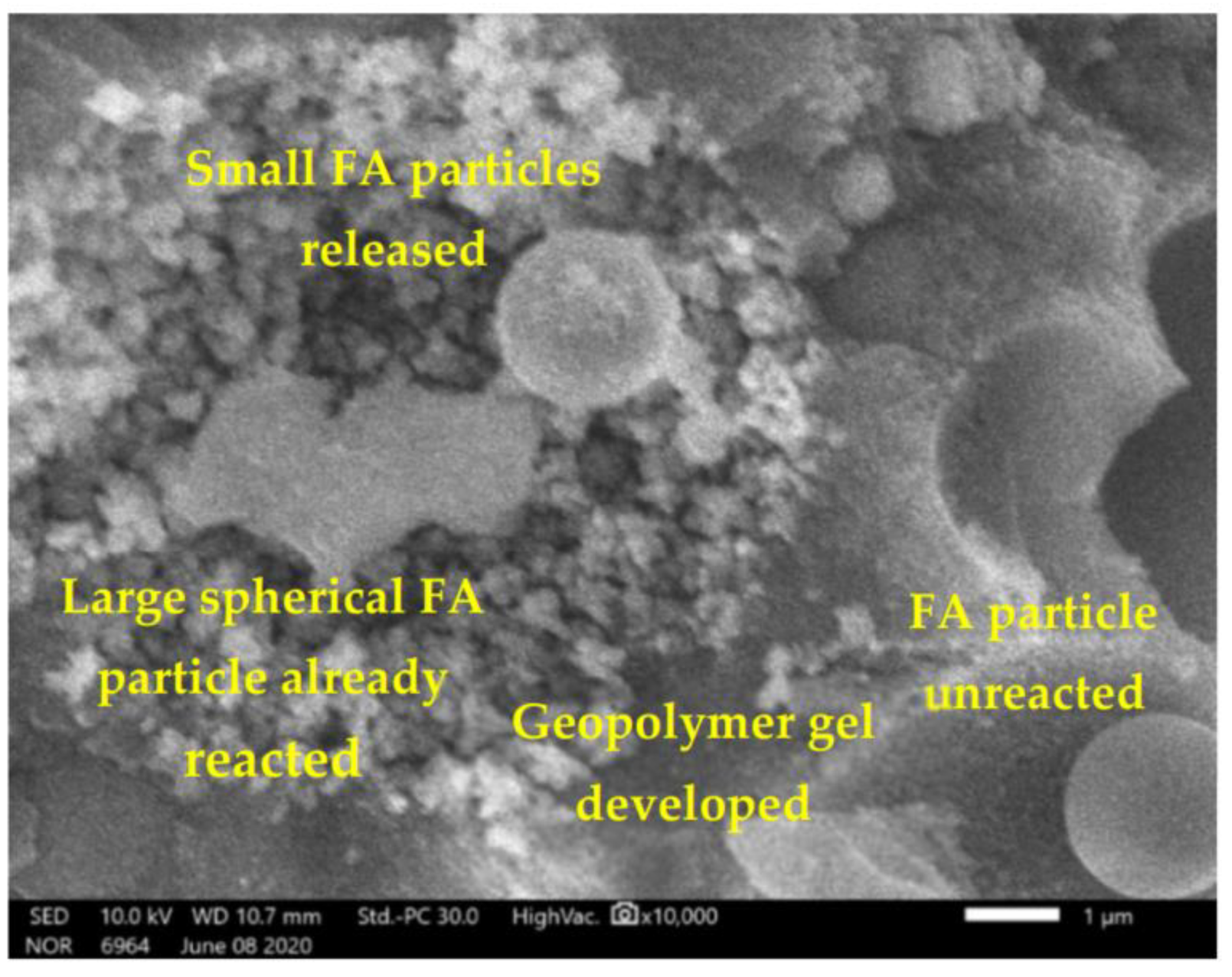

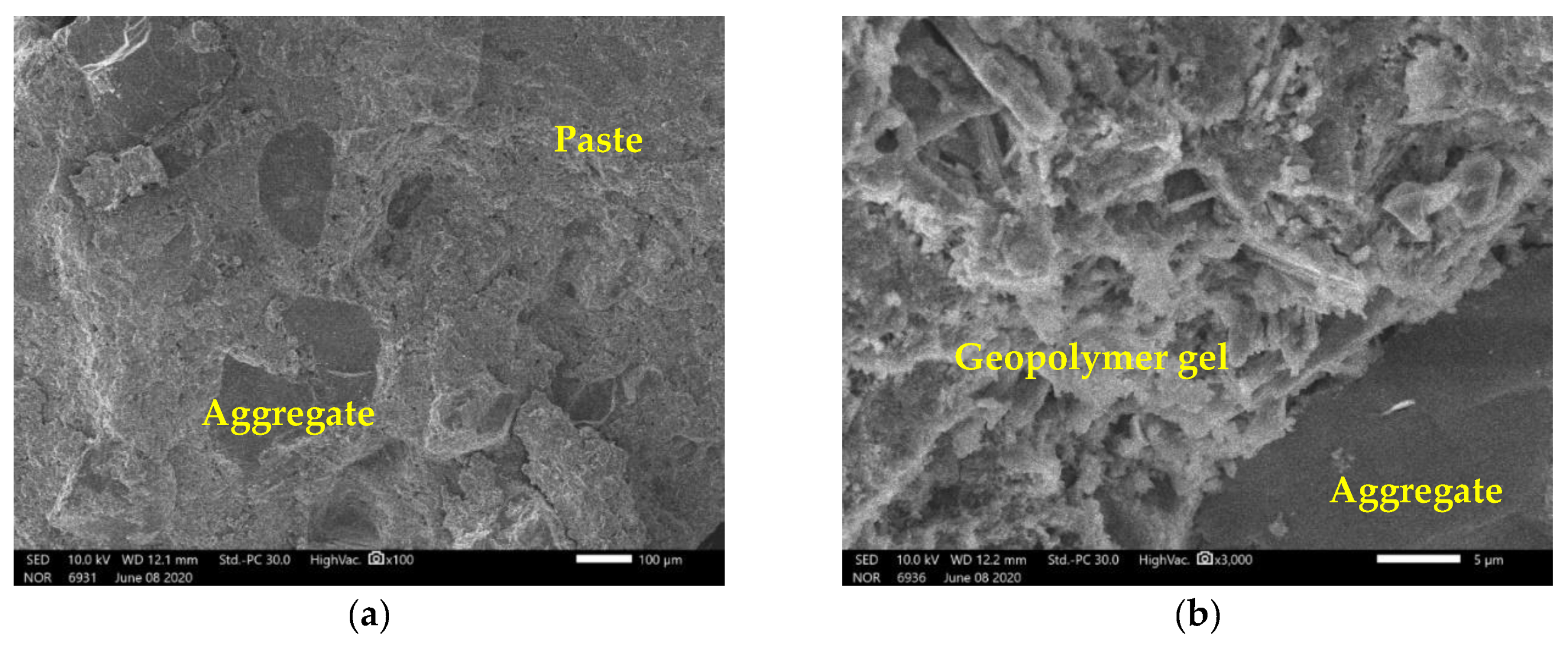

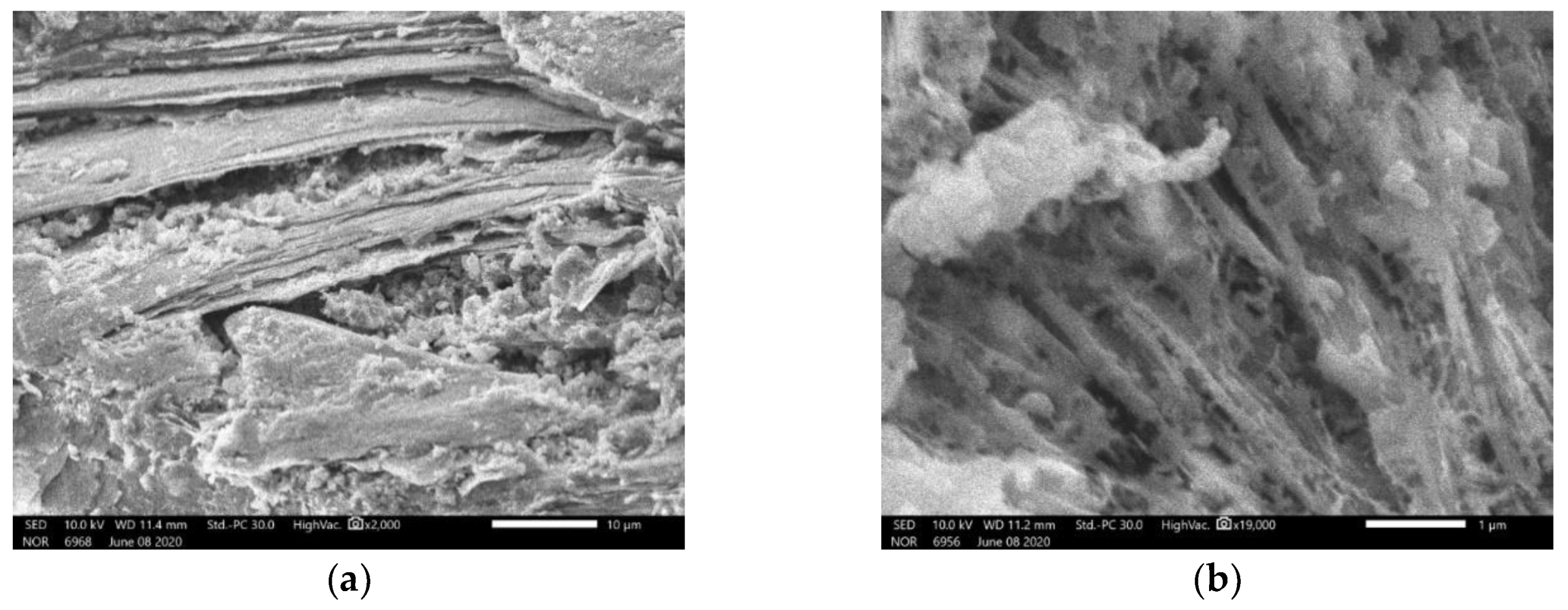



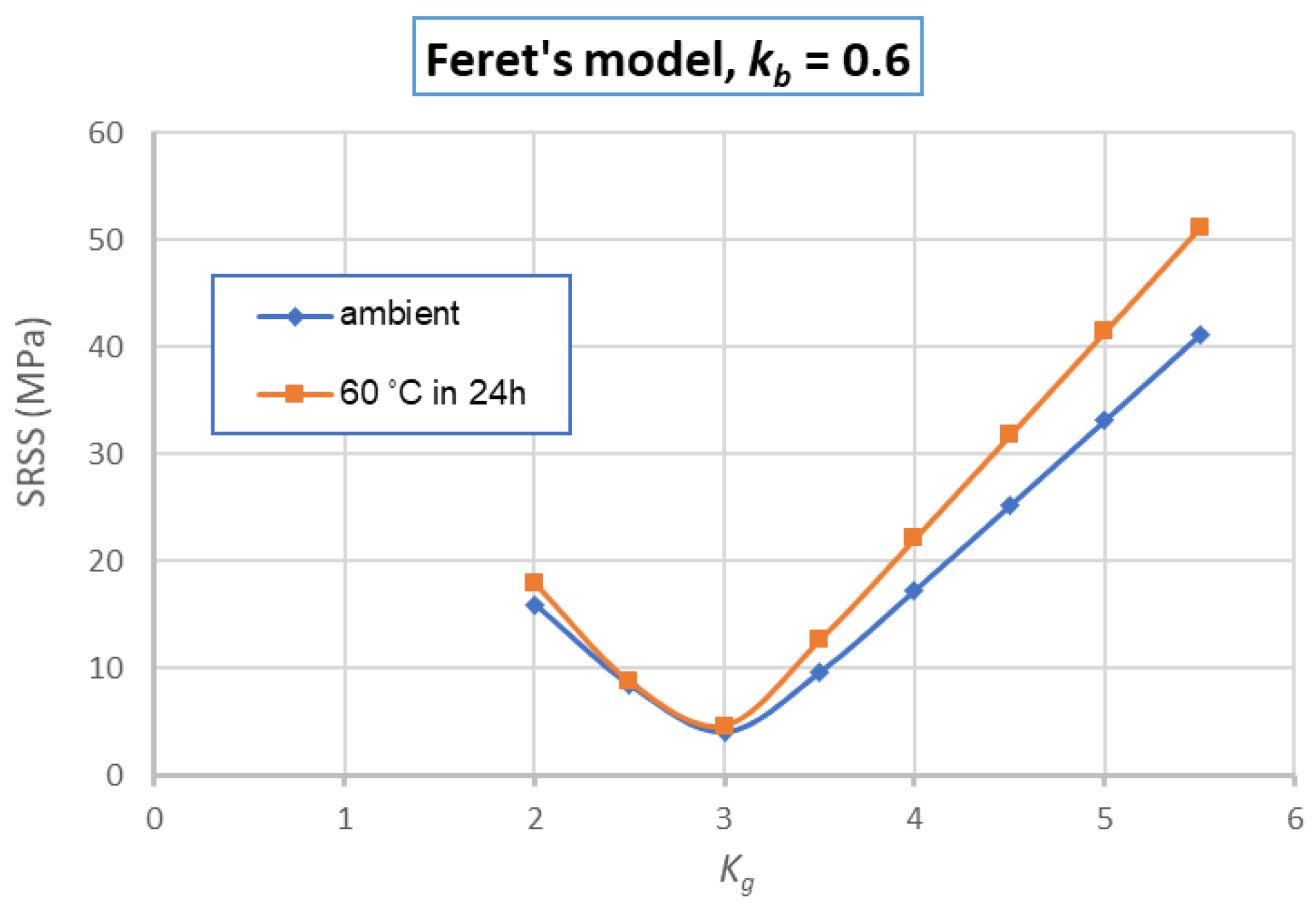
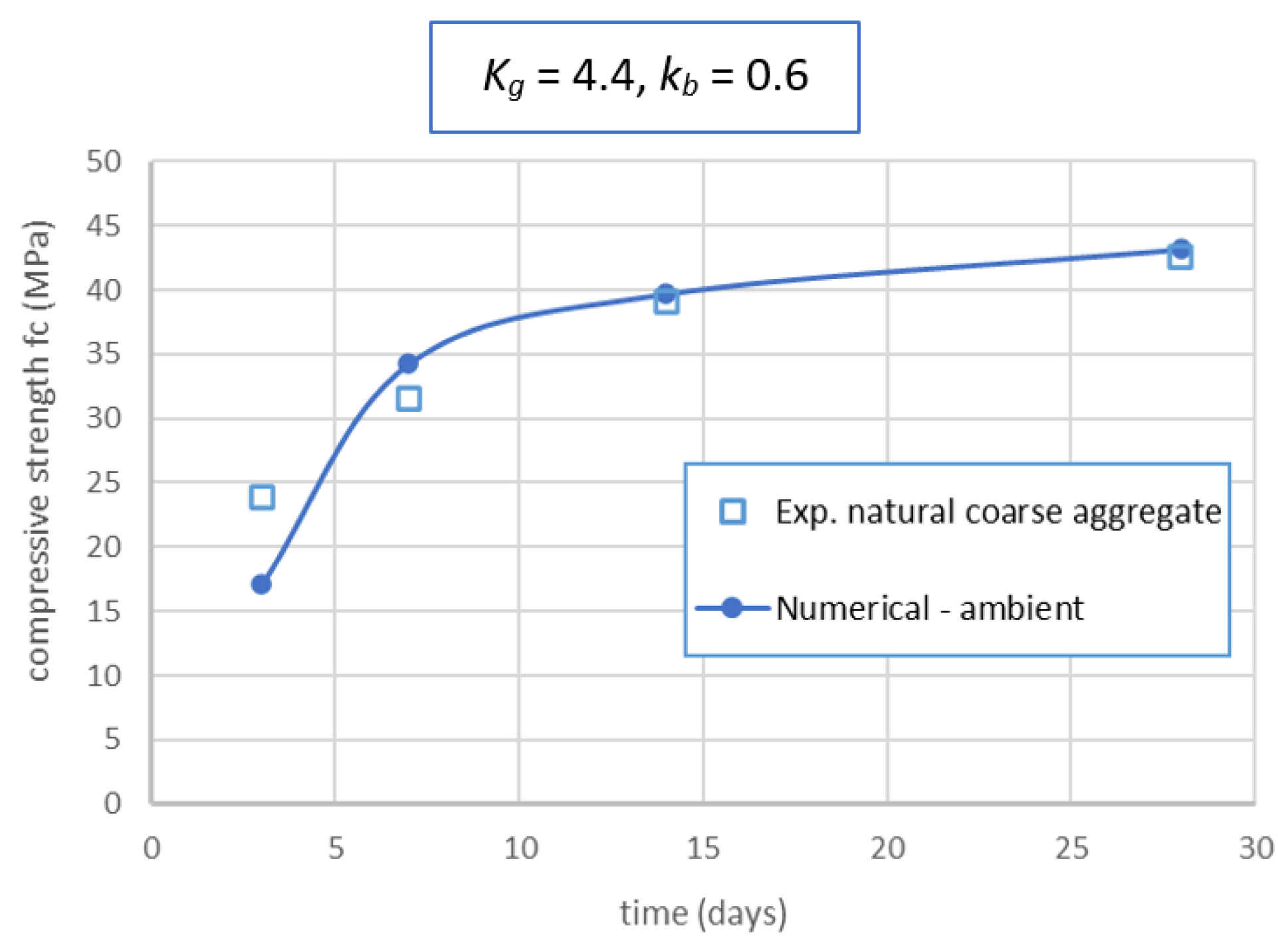
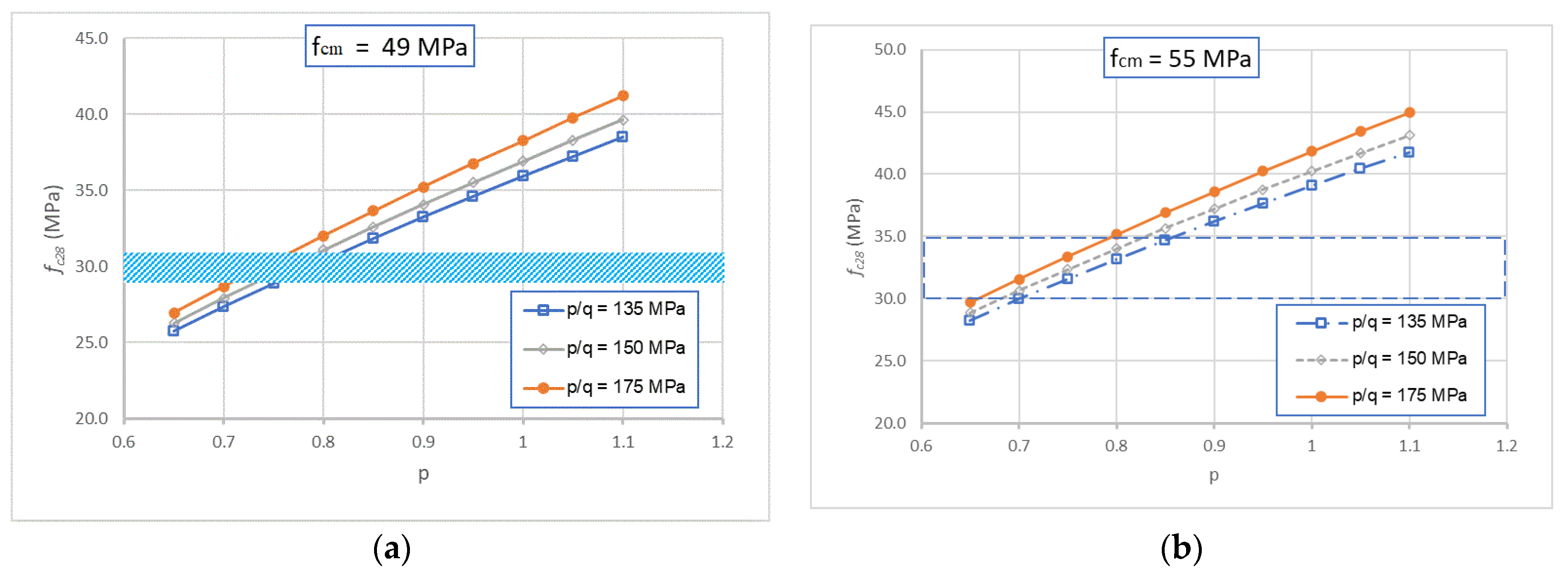

| Components | % in Mass |
|---|---|
| Sulfur trioxode (SO3) | 1.0 |
| Aluminum oxide (Al2O3) | 26.1 |
| Ferric oxide (Fe2O3) | 11.3 |
| Sodium oxide (Na2O) | 1.35 |
| Silicon dioxide (SiO2) | 51.1 |
| Potassium oxide (K2O) | 1.29 |
| Calcium oxide (CaO) | 4.7 |
| Magnesium oxide (MgO) | 1.7 |
| Moisture | 0.1 |
| Loss on ignition | 0.7 |
| Specific Gravity | Dry Density | Saturated Density | Water Absorption | ACV (Saturated) | Compressive Strength (MPa) | |
|---|---|---|---|---|---|---|
| Natural aggregates | 2.66 | 2.59 | 2.61 | 1.1% | 15.0% | 70 |
| Recycled coarse aggregates | 2.60 | 2.26 | 2.39 | 5.8% | 25.8% | 34 |
| AAS/FA | FA | Na2SiO3 | NaOH | Sand | RCA | Superplasticizer |
|---|---|---|---|---|---|---|
| 0.4 | 428 | 123 | 49 | 540 | 1260 | 8.28 |
| 0.45 | 414 | 133 | 53 | 540 | 1260 | 8.00 |
| 0.5 | 400 | 143 | 57 | 540 | 1260 | 7.74 |
| Composition (%) | Paste | Mortar | Mortar-Standard |
|---|---|---|---|
| FA | 71.3 | 37.5 | 22.7 |
| AAS | 28.7 | 15.1 | 9.1 |
| Sand | 0 | 47.4 | 68.2 |
| Cured Conditions | Age (Days) | |||
|---|---|---|---|---|
| 3 | 7 | 14 | 28 | |
| Ambient | 19.2 | 38.5 | 44.6 | 48.5 |
| 60 °C in 24 h | 32.3 | 48.5 | 52.3 | 54.6 |
Publisher’s Note: MDPI stays neutral with regard to jurisdictional claims in published maps and institutional affiliations. |
© 2021 by the authors. Licensee MDPI, Basel, Switzerland. This article is an open access article distributed under the terms and conditions of the Creative Commons Attribution (CC BY) license (http://creativecommons.org/licenses/by/4.0/).
Share and Cite
Le, H.-B.; Bui, Q.-B.; Tang, L. Geopolymer Recycled Aggregate Concrete: From Experiments to Empirical Models. Materials 2021, 14, 1180. https://doi.org/10.3390/ma14051180
Le H-B, Bui Q-B, Tang L. Geopolymer Recycled Aggregate Concrete: From Experiments to Empirical Models. Materials. 2021; 14(5):1180. https://doi.org/10.3390/ma14051180
Chicago/Turabian StyleLe, Hoai-Bao, Quoc-Bao Bui, and Luping Tang. 2021. "Geopolymer Recycled Aggregate Concrete: From Experiments to Empirical Models" Materials 14, no. 5: 1180. https://doi.org/10.3390/ma14051180






